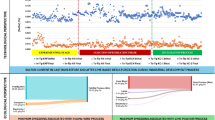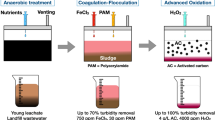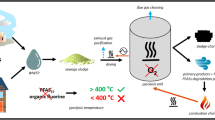Abstract
Red mud (RM) was produced during alumina production from bauxite known as the Bayer process. Arsenic was detected in the solid phase of RM (RMsf) which was disposed in the disposal area. This study investigates the effectiveness of using Zero-valent iron (ZVI), ferrihydrite, ferrous sulfate (FeSO4), waste acid (WA) or CO2 for immobilization of arsenic in the RMsf. To test the effect of the amendments on the arsenic leachability, the RMsf samples were amended with the iron-based materials or acidifiers at various w/w (weight/weight) ratios (1–10 %) for 30 days. The leachability of arsenic in the RMsf was evaluated by a 4-step water elusion process. After 30-day treatment of the RMsf, the leachability of As decreased from an initial (12.7 %) to (7.0 %) with a w/w ratio of 5 % ZVI (0 %) with 5 % FeSO4·7H2O, (3.4 %) with 5 % ferryhydrite, (2.0 %) with 6 % WA and (11.8 %) with 6 % CO2. FeSO4·7H2O and WA showed more effectively than other amendments for immobilizing arsenic. Arsenic fractionation with a sequential extraction procedure was used to evaluate the arsenic migration potential in the RMsf. FeSO4 and WA were effective in increasing the hydrous oxide combined arsenic in the RMsf. The leachable Cl− and SO4 2− in the RMsf increased from 2.9 to 14.1 mg/g and 19.9–44.4 mg/g with 6 % WA and 5 % FeSO4·7H2O added, respectively. The estimated cost of the FeSO4 and WA treatment was 0.47 and 0.49 USD per ton, respectively.




Similar content being viewed by others
References
Amstaetter K, Borch T, Larese-Casanova P, Kappler A (2010) Redox transformation of arsenic by Fe(II)-activated goethite (alpha-FeOOH). Environ Sci Technol 44:102–108
Bang S, Korfiatis GP, Meng X (2005) Removal of arsenic from water by zero-valent iron. J Hazard Mater 121:61–67
Datta R, Makris KC, Sarkar D (2007) Arsenic fractionation and bioaccessibility in two alkaline Texas soils incubated with sodium arsenate. Arch Environ Contam Toxicol 52:475–482
Davis CC, Chen HW, Edwards M (2001) Modeling silica sorption to iron hydroxide. Environ Sci Technol 36:582–587
Doyle P (2010) Hungary toxic disaster—entire villages to be abandoned. http://www.rense.com/general92/d32s.htm
Hug S, Leupin O (2003) Iron-catalyzed oxidation of arsenic (III) by oxygen and by hydrogen peroxide: pH-dependent formation of oxidants in the Fenton reaction. Environ Sci Technol 37:2734–2742
Klauber C, Gräfe M, Power G (2009) Review of bauxite residue “re-use” options
Li Y, Wang J, Luan Z, Liang Z (2010) Arsenic removal from aqueous solution using ferrous based red mud sludge. J Hazard Mater 177:131–137
Li Y, Wang J, Peng X, Ni F, Luan Z (2012) Evaluation of arsenic immobilization in red mud by CO2 or waste acid acidification combined ferrous (Fe 2+) treatment. J Hazard Mater 199–200:43–50
Liu H, Ma M, Qin M, Yang L, Wei Y (2010) Studies on the controllable transformation of ferrihydrite. J Solid State Chem 183:2045–2050
Manning BA, Fendorf SE, Goldberg S (1998) Surface structures and stability of arsenic(III) on goethite: spectroscopic evidence for inner-sphere complexes. Environ Sci Technol 32:2383–2388
Miretzky P, Cirelli AF (2010) Remediation of arsenic-contaminated soils by iron amendments: a review. Crit Rev Environ Sci Technol 40:93–115
Sahu RC, Patel RK, Ray BC (2010) Neutralization of red mud using CO2 sequestration cycle. J Hazard Mater 179:28–34
Seidel H, Görsch K, Amstätter K, Mattusch J (2005) Immobilization of arsenic in a tailings material by ferrous iron treatment. Water Res 39:4073–4082
Sherman DM, Randall SR (2003) Surface complexation of arsenic(V) to iron(III) (hydr)oxides: structural mechanism from ab initio molecular geometries and EXAFS spectroscopy. Geochim Cosmochim Acta 67:4223–4230
Soner Altundogan H, Altundogan S, Tümen F, Bildik M (2000) Arsenic removal from aqueous solutions by adsorption on red mud. Waste Manage 20:761–767
Sushil S, Batra V (2008) Catalytic applications of red mud, an aluminium industry waste: a review. Appl Catal B Environ 81:64–77
Tokoro C, Yatsugi Y, Koga H, Owada S (2009) Sorption mechanisms of arsenate during coprecipitation with ferrihydrite in aqueous solution. Environ Sci Technol 44:638–643
Waychunas G, Rea B, Fuller C, Davis J (1993) Surface chemistry of ferrihydrite: part 1. EXAFS studies of the geometry of coprecipitated and adsorbed arsenate. Geochim Cosmochim Acta 57:2251–2269
Wenzel WW, Kirchbaumer N, Prohaska T, Stingeder G, Lombi E, Adriano DC (2001) Arsenic fractionation in soils using an improved sequential extraction procedure. Anal Chim Acta 436:309–323
Xenidis A, Stouraiti C, Papassiopi N (2010) Stabilization of Pb and As in soils by applying combined treatment with phosphates and ferrous iron. J Hazard Mater 177:929–937
Zhang M, Pu J (2011) Mineral materials as feasible amendments to stabilize heavy metals in polluted urban soils. J. Environ Sci China 23:607–615
Acknowledgments
Financial support provided by the National High Technology R&D Program (863) from Ministry of Science & Technology of China (under Grant No. 2008AA06A409-3, 2011AA060701), and Shanghai Tongji Gao TingYao Environmental Science & Technology Development Foundation.
Author information
Authors and Affiliations
Corresponding author
Rights and permissions
About this article
Cite this article
Li, Y., Wang, J., Su, Y. et al. Evaluation of chemical immobilization treatments for reducing arsenic transport in red mud. Environ Earth Sci 70, 1775–1782 (2013). https://doi.org/10.1007/s12665-013-2265-7
Received:
Accepted:
Published:
Issue Date:
DOI: https://doi.org/10.1007/s12665-013-2265-7




